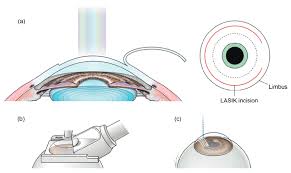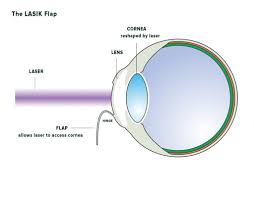Table of Contents
ToggleC3R, also known as Corneal Collagen Crosslinking with Riboflavin, is a corneal surgery to treat Keratoconus. It is a non-invasive procedure used to treat a condition where a patient’s eye’s cornea cannot hold its shape. Keratoconus is a bilateral corneal condition mostly common among people with allergies. It can typically start in adolescence and early adulthood. The diagnosis for this condition is usually unpredictable. Sometimes, if both eyes are affected, it might lead to severe vision issues, such as the inability to drive a car or read. In case it gets serious, C3R surgery might be the only option.
The cornea is one of the eye’s main parts, usually spherical. The cornea consists of about a hundred layers linked to each other with the help of collagen. If these collagens are lost, the cornea begins to thin and stretch rapidly, gradually spreading in both eyes. Some of the main causes that lead to Keratoconus are rubbing your eyes, family history of Keratoconus, disorders such as Down’s syndrome, and ocular allergy, which can also be caused by long-term contact lens wear.
The symptoms can be minor to severe. In its early stage, Keratoconus may show a need to wear spectacles. As the condition progresses, the vision gradually begins to deteriorate. Vision problems begin to worsen, and night vision is sometimes poor. Some people develop photophobia, which means sensitivity to bright lights, whereas others have redness or a feeling of irritation in their eyes. Sometimes, there is no pain sensation, making diagnosing difficult.
Diagnosis is usually made by an ophthalmologist who considers taking a detailed eye examination to come to a final and accurate conclusion. In its early stage, Keratoconus is difficult to diagnose since it does not show any identifiable signs and can be tricky. However, eye specialists usually use corneal topography, where an automated instrument determines the shape of the cornea by analyzing a digital image. The image revealed in the topography reveals distortions in the cornea. It can usually be treated with lenses and glasses, but vision might be difficult to maintain as the condition worsens. In such cases, wearing contact lenses can be temporary, and one might need surgery. The cornea will have to be replaced surgically with a transplant. Vision recovery after surgery or transplant takes time, often a year to eighteen months. However, even after the surgery, there is a possibility that the eyes will need contact lenses to see properly. Thus, C3R surgery cannot be the perfect solution for this condition, nor is it an alternative to contact lenses or glasses.
Keratoconus treatment is usually done successfully through C3R surgery, which is considered the permanent solution. Temporary treatment for this condition includes contact lenses. After the surgery, the patients should take a few postoperative measures as advised by their surgeons. The ophthalmologist will closely monitor your progress and provide detailed postoperative guidelines. The success of any surgery does not end after the surgery is completed. Following the postoperative care instructions is crucial to regain visual acuity. It is extremely important to follow these instructions to ensure a smooth recovery period.
Eye Protection –
It is important to wear protective eyeglasses or eye patches to protect the treated eyes from external factors such as accidental rubbing or dust.
Restrictive activities –
In the first stage of recovery, the patient is advised to avoid heavy lifting or strenuous exercise such as swimming, which could expose their eyes to dirt, water, or other irritants.
Follow-up Appointments –
It is important for the patients not to attend all follow-up appointments to monitor their progress, remove any protective shields, and further evaluate the recovery process.
Pain management –
It is one of the crucial factors of C3R surgery. De-epithelialization of the cornea after surgery causes some discomfort and pain, which needs to be addressed to have a smooth and speedy recovery. There is a need for proper counseling of the patients who have undergone surgery and understand the level of pain they might be experiencing. Common analgesics are a helpful pain management strategy recommended by eye specialists.
Epithelialization –
After the surgery, most hospitals provide their patients with soft contact lenses, whose primary function is to support epithelialization. Additionally, the contact lens reduces the pain. Patients are also usually put on antibiotics to prevent further infection. Once re-epithelialization is finished, contact lenses and antibiotics are no longer required in most cases. Instead, patients are given a steroid regimen for about three weeks. If any patient suffers from mild pain, hospitals usually recommend anti-inflammatory drugs.
Contact lenses after Corneal Collagen Crosslinking (C3R) surgery
In the early stages of Keratoconus, rigid contact lenses are recommended by ophthalmologists. Spectacles are preferred to correct minor astigmatism. As the condition progresses, spectacles may not be ideal for understanding vision, and most specialists recommend contact lenses. Though C3R surgery reduces cylindrical power and will improve the quality of your vision, a patient still has to wear corrective glasses or contact lenses, as per the recommendation from their respective ophthalmologists.
Complications After C3R Surgery
Corneal cross-linking is a safe procedure with few side effects and has been proven to be a beneficial surgery for patients with keratoconus conditions. However, some side effects and complications have been seen after the surgery. These include minor complications such as haze and sterile infiltrates to severe conditions such as corneal infection or the development of stromal scars. One of the most severe side effects has been infections which tend to occur in patients with some conditions such as neurodermatitis and asthma.
Another possible complication in patients undergoing C3R surgery is a deep corneal scar, which generally happens in patients with a medical predisposition, such as people with thin corneas. Additionally, haze is a common and minor side effect of cross-linking. However, this haze must be addressed seriously and differentiated from the haze that occurs after refractive excimer laser. Haze occurs after corneal crosslinking, is faint and minor, and usually goes away with topical steroid treatment.
However, in some patients, fine haze remains even after months of surgery, which usually affects the crosslinked area. Such haze does not usually affect visual acuity and mostly occurs due to structural changes in the tissue crosslinked during the surgery.













